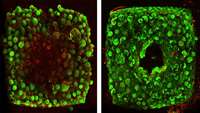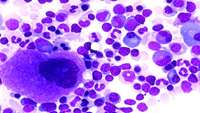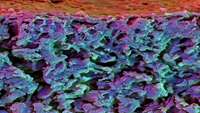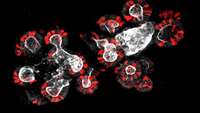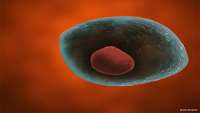A swifter way towards 3D-printed organs
20 people die every day waiting for an organ transplant in the United States, and while more than 30,000 transplants are now performed annually, there are over 113,000 patients currently on organ waitlists
A critical factor for wound healing
The p53 family of transcription factors (p63 and p73) plays critical roles in keratinocyte (skin cell) function.
Megakaryocytes act as bouncers restraining cell migration in the bone marrow
Hematopoiesis is the process of forming blood cells, which occurs predominantly in the bone marrow. The bone marrow produces all types of blood cells: red blood cells, platelets, and white blood cells (leucocytes). One of the most prominent white blood cell types are neutrophils—they help the body fight against infections and are the most abundant subpopulation of leukocytes. They are short-lived and highly mobile, and can enter parts of tissue where other cells/molecules cannot.
Can magnetic stem cells improve cartilage repair?
Cells equipped with superparamagnetic iron oxide nanoparticles (SPIOs) can be directed to a specific location by an external magnetic field, which is beneficial for tissue repair.
Multiple organs produced at once with iPS cells
A Japanese research group has successfully produced multiple organs simultaneously, using human iPS cells, or induced pluripotent stem cells.
Team pioneers cancer treatment that targets bone metastases while sparing bone
University of California, Irvine researchers have developed and tested on mice a therapeutic treatment that uses engineered stem cells to target and kill cancer bone metastases while preserving the bone.
Repair of aged tissue can be enhanced by inhibiting signals from neighbouring cells
Researchers at the University of Helsinki have discovered how regenerative capacity of intestinal epithelium declines when we age. Targeting of an enzyme that inhibits stem cell maintaining signaling rejuvenates the regenerative potential of an aged intestine
Researchers identify a key regulatory mechanism in the development of normal pluripotent embryonic cells
The early development of embryos is not well understood. One necessary stage is the formation of the blastocyst, a collection of cells present by about 4 days after fertilization of the egg, before implantation in the uterus. From that tiny collection of cells, all the different cells in the body must be created.
Results of breakthrough trial for cell-based stroke therapy revealed
In a Stem Cells publication, researchers from the University of Texas Health Science Center at Houston (UTHealth; TX, USA) detail the results of a landmark Phase I clinical trial investigating the use of autologous, bone marrow-derived cells in the treatment of ischemic stroke.
An EpiPen for spinal cord injuries
An injection of nanoparticles can prevent the bodys immune system from overreacting to trauma, potentially preventing some spinal cord injuries from resulting in paralysis.


